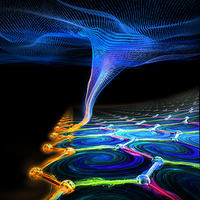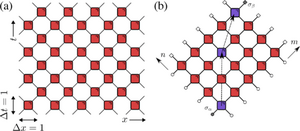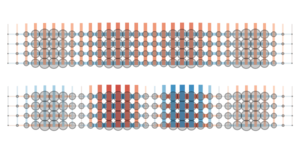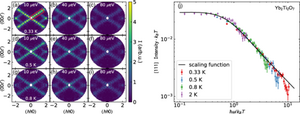
Publications
Please see https://www.pks.mpg.de/research/publications for a comprehensive list of MPI-PKS publications
Recent publication highlights
Engineering and Probing Non-Abelian Chiral Spin Liquids Using Periodically Driven Ultracold Atoms

We propose a scheme to implement Kitaev’s honeycomb model with cold atoms, based on a periodic (Floquet) drive, in view of realizing and probing non-Abelian chiral spin liquids using quantum simulators. We derive the effective Hamiltonian to leading order in the inverse-frequency expansion, and show that the drive opens up a topological gap in the spectrum without mixing the effective Majorana and vortex degrees of freedom. We address the challenge of probing the physics of Majorana fermions, while having access only to the original composite spin degrees of freedom. Specifically, we propose to detect the properties of the chiral spin liquid phase using gap spectroscopy and edge quenches in the presence of the Floquet drive. The resulting chiral edge signal, which relates to the thermal Hall effect associated with neutral Majorana currents, is found to be robust for realistically prepared states. By combining strong interactions with Floquet engineering, our work paves the way for future studies of non-Abelian excitations and quantized thermal transport using quantum simulators.
Bo-Ye Sun, Nathan Goldman, Monika Aidelsburger, and Marin Bukov
PRX Quantum 4, 020329 (2023) [link]
From Dual Unitarity to Generic Quantum Operator Spreading

Dual-unitary circuits are paradigmatic examples of exactly solvable yet chaotic quantum many-body systems, but solvability naturally goes along with a degree of nongeneric behavior. By investigating the effect of weakly broken dual unitarity on the spreading of local operators, we study whether, and how, small deviations from dual unitarity recover fully generic many-body dynamics. We present a discrete path-integral formula for the out-of-time-order correlator and recover a butterfly velocity smaller than the light-cone velocity, vB<vLC, and a diffusively broadening operator front, two generic features of ergodic quantum spin chains absent in dual-unitary circuit dynamics. The butterfly velocity and diffusion constant are determined by a small set of microscopic quantities, and the operator entanglement of the gates has a crucial role.
Michael A. Rampp, Roderich Moessner, and Pieter W. Claeys
Phys. Rev. Lett. 130, 130402 (2023) [link]
Fragmented Cooper Pair Condensation in Striped Superconductors

Condensation of bosons in Bose-Einstein condensates or Cooper pairs in superconductors refers to a macroscopic occupation of a few single- or two-particle states. A condensate is called “fragmented” if not a single, but multiple states are macroscopically occupied. While fragmentation is known to occur in particular Bose-Einstein condensates, we propose that fragmentation naturally takes place in striped superconductors. To this end, we investigate the nature of the superconducting ground state realized in the two-dimensional t−t′−J model. In the presence of charge density modulations, the condensate is shown to be fragmented and composed of partial condensates located on the stripes. The fragments of the condensates hybridize to form an extended macroscopic wave function across the system. The results are obtained from evaluating the singlet-pairing two-particle density matrix of the ground state on finite cylinders computed via the density matrix renormalization group method. Our results shed light on the intricate relation between stripe order and superconductivity in systems of strongly correlated electrons.
Alexander Wietek
Phys. Rev. Lett. 129, 177001 (2022) [link]
Dynamical Scaling as a Signature of Multiple Phase Competition in Yb2Ti2O7

Yb2Ti2O7 is a celebrated example of a pyrochlore magnet with highly frustrated, anisotropic exchange interactions. To date, attention has largely focused on its unusual, static properties, many of which can be understood as coming from the competition between different types of magnetic order. Here we use inelastic neutron scattering with exceptionally high energy resolution to explore the dynamical properties of Yb2Ti2O7. We find that spin correlations exhibit dynamical scaling, analogous to behavior found near to a quantum critical point. We show that the observed scaling collapse can be explained within a phenomenological theory of multiple-phase competition, and confirm that a scaling collapse is also seen in semiclassical simulations of a microscopic model of Yb2Ti2O7. These results suggest that dynamical scaling may be general to systems with competing ground states.
A. Scheie, O. Benton, M. Taillefumier, L. D. C. Jaubert, G. Sala, N. Jalarvo, S. M. Koohpayeh, and N. Shannon
Phys. Rev. Lett. 129, 217202 (2022) [link]
